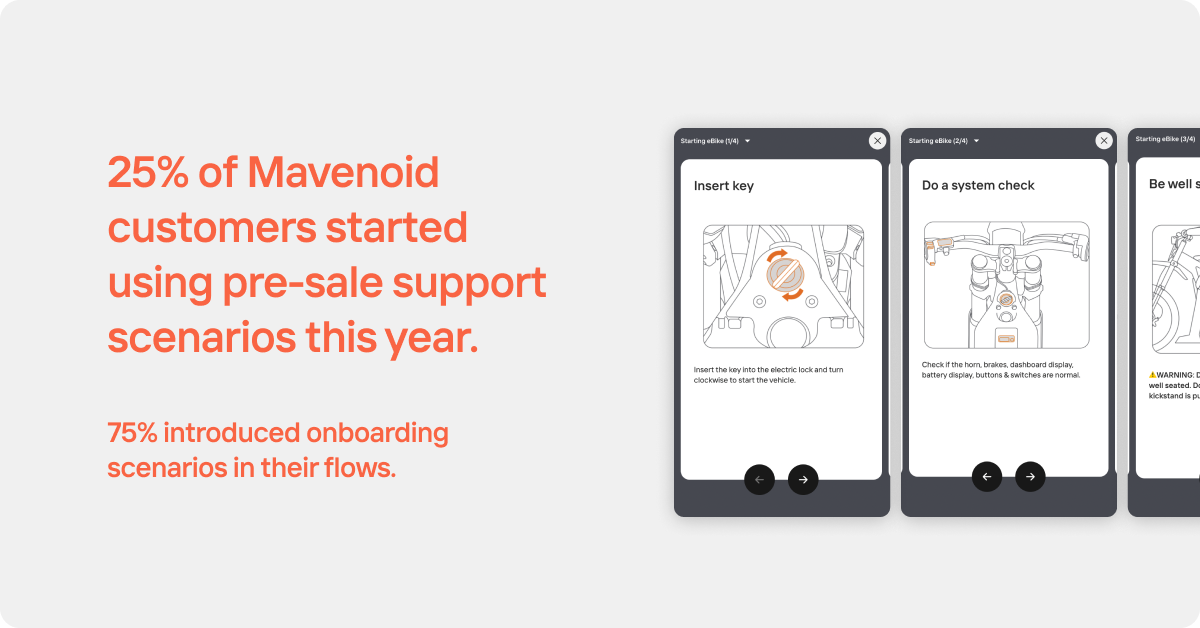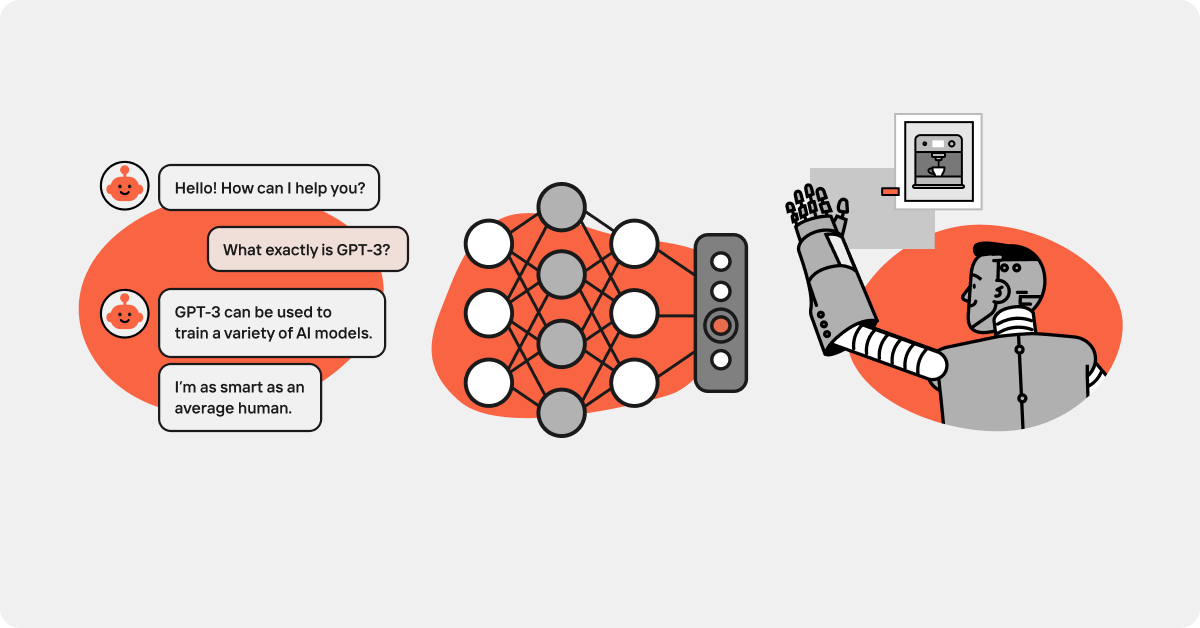2022 has definitely been an interesting, yet challenging year for the hardware industry.
The recession and geopolitical unrest that followed the pandemic's first two years, as well as changes in customer behavior and preferences, supply chains, and sales strategies, all affected how hardware businesses manage their product support.
At Mavenoid, in 2022 we doubled down on our vision to provide every customer in the world with an expert for any product at their fingertips. Our team stayed laser-focused on hardware products and hardware-powered services, listened to our customers, and prioritized building the solutions that would solve their most pressing business challenges.
With our recent $30M Series B round of funding, we plan to continue scaling product development to ensure everyone in the world has access to the great product support they deserve.
Let's take a moment to reflect on the hardware support trends we've seen this year, and revisit some of the product updates that have been, and continue to be, the most impactful for our customers.
Industry trends that influenced Mavenoid product roadmap in 2022
Trend #1: Crisis mode is the new normal
The majority of hardware companies experienced supply chain issues, which delayed product deliveries, made repairs more difficult, and raised the cost of returns. This inevitably resulted in an increase in the number of support requests.
Companies had to adjust to remote work and deal with the "big resignation" that had an impact on support teams. It is now much more difficult to hire, onboard, and retain support agents, particularly for global brands. Because human assistance is costly, there is a greater demand for intelligent self-service options that can be integrated across all channels and geographies.
These trends influenced our product team's decision to prioritize improving the efficiency of our self-service support offering, allowing brands to provide seamless support to their customer base while reducing overhead costs.

The full overhaul of end-user experience brought to life our Next-Gen Assistant. Now more than 80% of Mavenoid customers are using the Next-Gen Assistant to run their product support. What we’ve seen as a result:
- In comparison to the previous version of the assistant, the Next-Gen assistant generates 56% more sessions since it is more noticeable to end users. This ensures that self-service support options are used significantly more frequently, leading to quicker time to resolution, and decreased load on support teams;
- Thanks to enhanced end-user navigation and the ability to include more visual instructions, resolution rates increased by 9% on average;
- The average consumer happiness rate is now 7% higher, as 81% of end users rated their experience as “good” or “great”.
Mavenoid is now available in more channels, including web, mobile, search and IVR. This year we also launched Assistant Webpages – snippets of support content from the hardware brand website that customers see at the top of Google search results when looking for information on a particular product, or attempting to fix problems.
Customers are instantly directed to the official product pages powered by Mavenoid rather than having to search through unofficial support content. Assistant Webpages resemble Mavenoid’s product assistant, and are designed to maximize the likelihood that the end user will actually resolve their issue on their own instead of interacting with third-party sources that will likely lead them to contacting the brand support anyway.
Trend #2: Customers spend more time in pre-purchase research, and choose more sustainable products
Customer confidence is at a 5-year low as a result of the financial uncertainty of the last three years. This causes people to delay major purchases, such as large home appliances, and pay more attention to energy efficiency. Consumers spend more time and effort choosing the right product, and prefer to repair rather than replace their existing products.

In terms of product support, this led to increased adoption of pre-sale support scenarios - more than 25% of our customers have those in their Mavenoid assistant. Better onboarding scenarios are also becoming more popular, with 75% of customers using them. This makes a lot of sense for preventing non-faulty returns (which frequently occur as a result of purchasing the incorrect product) and additional support requests caused by improper product use.
As support teams developed and launched significantly more new scenarios and flows, we improved collaboration on content creation and modeling by focusing on simultaneous work, flexible access management, and the security of content updates.
We recently rolled out new Roles and Permissions. Each user can now have one or more roles assigned to them, such as Live Support Agent, Analyst, Translator, etc. Each role has pre-defined permissions giving it the appropriate access rights that employees typically need to do their job. As a result, creating new self-service workflows is much easier than before. Moreover, sensitive data (e.g. auto-refund rules) can be locked so that only users with the necessary permissions can change or update it.
On the content management side, we invested in real-time collaboration, which makes creating and improving support flows collaboratively much easier and more delightful. Everyone feels more confident when making changes now that creators can track edits as they happen and see who else is working on the same flow.
Managing changes to self-service support scenarios is now much safer and more intuitive. Thanks to the new Version History feature, content creators can see who made the edits and when they were made, as well as undo changes by reverting to a previous version.
Trend#3: Brands are introducing innovative business models, and evolving their sales and distribution strategies
Brands are increasingly moving away from traditional sales through large retailers towards direct sales through their own e-commerce platforms. They create digital engagement platforms with the goal of owning the customer relationship end-to-end, as well as creating more tailored offerings and new revenue opportunities throughout the product's lifetime.
In reaction to changes in consumer behavior, new business models are also becoming more prevalent. For instance, companies are starting to "servitize" their products by offering subscriptions for software and consumables, premium service packages, and extended warranties. Some of the most innovative brands experiment with offering shared ownership of products instead of purchasing outright.
Product support is an essential part of these experiences, increasing requirements for coverage of products, topics, workflows, and regions.
Mavenoid has always been proud of its ease of integration with channels, tools and workflows. This year, we focused on the ease of use and flexibility of integrations with CRM and e-commerce solutions to help brands personalize their product support and provide a more comprehensive experience for their customers.
One-click integrations for CRMs such as Salesforce and Zendesk are excellent examples of this. Thanks to pre-built CRM connectors, brands can automatically log each Mavenoid conversation as a ticket or support case, ensuring that teams have access to all customer information. These tickets include customer details, self-service history, agent notes, tags, and statuses, which is helpful for intelligent routing and reporting. And if customers return to add more information to their existing tickets, we'll update them without creating duplicate tickets for the issue.
We also improved our custom integrations via External API Actions, allowing brands to connect Mavenoid Assistant to any API-enabled tool to push or fetch data.

Our product team is continuously impressed with the flows our customers automate with API Actions. Micromobility providers, for example, use them to automate routine refunds for e-scooter rentals. Mavenoid automatically triggers a refund when a customer demands $3 back for a ride lasting less than 100 meters or five minutes and does not have a history of making repeated refund requests. The return on investment is obvious: manually processing the refund would have cost more than the payout itself, and the end user who is eligible for the refund is delighted with the quick turnaround of their request.
Trend #4: Increasing complexity of hardware products and their support
Because of their life span, variety of models, and limited options for updates or upgrades, hardware products have always been more complicated to support than software or consumer goods. Mavenoid is well aware of these challenges; it is what our product was built for from day 1.
Although the volume of knowledge required to support hardware products is increasing, it is still poorly organized and not searchable. Companies have thousands of product manuals, FAQs, and instructions, but customers are still struggling to find answers to basic questions.
In 2022 we set out to make all existing content available to customers and easily searchable. Our improved Knowledge Sync integration with Salesforce, Zendesk, and other well-known CRM and CMS platforms organize all existing articles into reusable Mavenoid components quickly. Updates are also synchronized, allowing content creators to work in their preferred tool while contributing to self-service Assistant.
Another innovation is "AI Retrieval," which responds to customer inquiries by extracting relevant information from documents such as manuals, instructions, webpages, and so on. It enables businesses to achieve 100% product portfolio coverage in their Mavenoid self-service assistant in a matter of a few hours by leveraging all currently available documentation.
But retrieving and uploading all of the content is only the first step; the next challenge is organizing it so that the AI assistant only asks relevant questions and provides accurate answers. To successfully resolve this challenge, we improved content organization at all levels, from a single node to the entire flow.
To streamline content creation and updates, we maximized the options for re-using content blocks like components, step-by-step guides, and images. Modelers only need to create them once and then reuse them across multiple support flows. The same is true for updates: content blocks can be updated from a central location, reducing the time and effort required to keep your Product Assistant up-to-date.

Finally, we improved and integrated self-service translation management into the Mavenoid Admin app. Brands can now localize self-service support content in minutes for a fraction of the cost of human translations. This is made possible by an AI-powered engine that generates high-quality translations in dozens of popular languages such as English, French, German, and Chinese. For those who still prefer the human translation, we provide that option in the Admin app as well: you can invite translators, give them limited access, and ask them to review existing content or translate from scratch.
All of these updates save support teams a significant amount of time by reducing the effort required to write, organize, and update support content.
Trend #5: AI and cloud platform adoption unlock new levels of efficiency in customer support

This is the most optimistic trend on our list; we see many positive technological changes that will enable better, more efficient support.
Cloud platform adoption is increasing across the board, from CRM, field service, and call centers to fleet management and IoT. These platforms have APIs and can be connected to Mavenoid to increase automation and personalization while also making support more proactive.
And, of course, the rise of AI is very promising - with the latest developments in text generation such as GPT-3, text-to-image, and text-to-video, it is now possible to create, translate, and maintain support content at a fraction of the cost, faster.
This and many more trends will be shaping how hardware product support will be evolving in 2023. Mavenoid team is looking forward to yet another year of finding solutions for and with our customers.
We will be back early next year with an overview of trends we expect to impact hardware product support significantly in 2023. Stay tuned, and visit our blog to follow monthly product updates and learn about industry trends, insights, and best practices.
Here’s to another year of great product support 🥂!
Want more insights? Join Mavenoid’s Product Support Community to discuss your key takeaways for 2022 with support leaders from leading global hardware and electronics companies.
